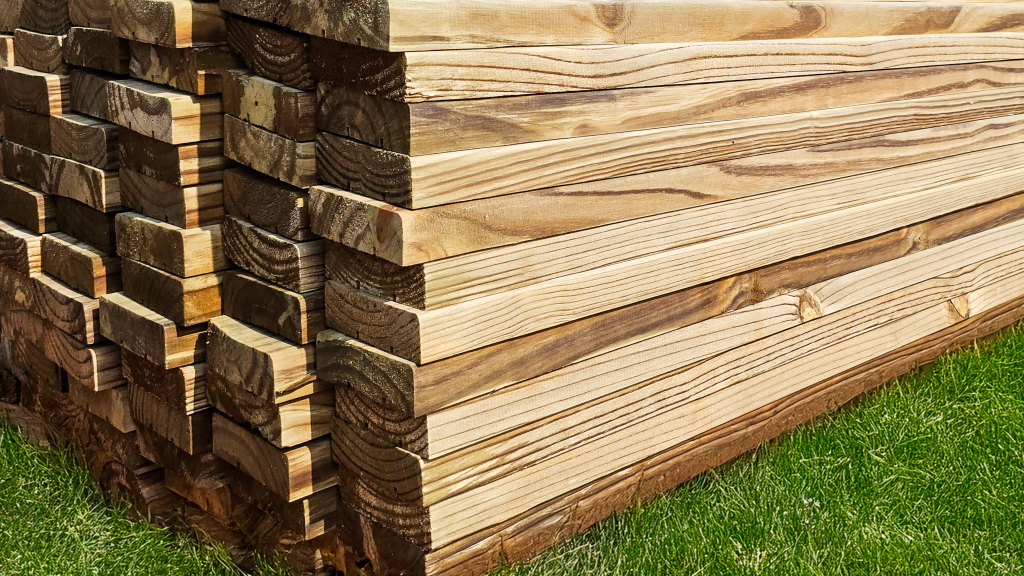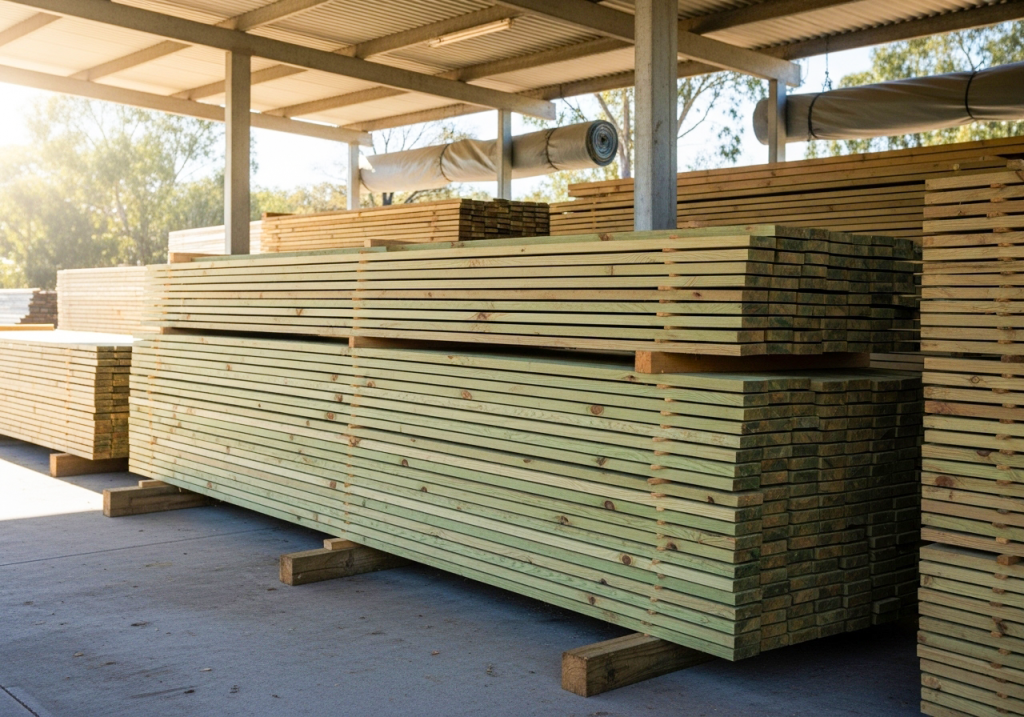What if the most sustainable, cost-effective lumber decking option has been right in front of you all along? Here’s how you can get ahead of the next big trend in 2026 before anyone else.
Decking has evolved far beyond the old wooden patio. Today, it’s a design statement, shaped by innovation, sustainability, and a growing love for natural textures. Sure, composite options have their moments; however, as technology advances, so does our awareness of what truly matters: durability, affordability, and a lighter footprint on the planet.
And here’s the twist, sometimes the greenest choice is also the simplest one. Lumber, in its pure and natural form, still stands out as a champion of both beauty and sustainability. While hardwoods remain a classic favorite, another alternative is catching the attention of smart retailers and builders alike.
In this post, you’ll discover what makes this alternative so appealing, why it’s rapidly gaining traction, and how it can boost both your sales and customer satisfaction.

Introducing CCA-treated Pine Lumber Decking.
It’s time to give credit where it’s due. CCA-treated Pine Lumber Decking deserves the spotlight, not only as an affordable option, but as a powerful performer in today’s decking market.
Although Pine is categorized as a softwood, it’s widely recognized for its impressive strength and resilience. It offers higher compressive, bending, and density values than many other softwoods. This makes it versatile enough for both light structural use and more demanding applications. Pine’s tensile strength typically ranges between 70 and 116 MPa, depending on the type of load. It also provides excellent elasticity and impact resistance.
While softer than most hardwoods, its overall strength and reliability make Pine a preferred material for construction and woodworking projects. Joinery, cladding, flooring, ceiling, and decking, to name a few.
Furthermore, through advanced preservation treatment, Pine is also transformed into a durable, weather-resistant material. It can handle the elements with ease, all while maintaining its natural beauty.
At Sabie Poles, we primarily supply CCA-treated Pine Decking, as we recognize the critical role that proper treatment plays in protecting lumber and enhancing its long-term durability. However, we also understand that some clients may prefer alternative treatment options that are viewed as more environmentally conscious or safer. An example is TAN-E, which we can provide upon request. For projects that require it, we can also supply untreated decking.
For retailers, this means you can confidently offer your customers decking that suits their exact needs, whether they prioritize durability, sustainability, or a natural finish, or all at once.
The Effects of CCA Treatment on Pine Lumber Decking
Before we continue, you must understand clearly what the CCA treatment is. This is because the treatment is the one factor that plays a pivotal role in the durability of Pine lumber overall.
CCA treatment, or Copper Chrome Arsenate treatment, is a wood preservation that protects lumber from decay, insect attack, and fungal damage.
During this process, a water-based preservative containing copper, chromium, and arsenic is pressure-infused into the wood, ensuring deep and long-lasting protection. The copper acts as a fungicide, the arsenic protects against insects and borers, and the chromium binds these elements to the lumber’s fibres.
The durability of preservative-treated wood is entirely determined by the type of preservative applied, the concentration of treatment in the lumber, and the level of exposure to potential hazards.
Extensive testing has shown a direct link between the amount of preservative required to ensure a long, reliable service life and the likelihood of damage from insects or fungi in a specific application, such as decking.
South Africa uses a rating system similar to international standards. In this system, higher hazard numbers indicate a greater risk to the wood and a need for a higher preservative concentration. These hazard classes range from H1 to H6. While Pine lumber decking is typically treated to H2, we go further by treating our decking to H3, ensuring it is more than capable of handling demanding conditions.
To learn more about the CCA treatment process, you can read our blog: Timber and the CCA pressure treatment process

The current decking landscape
According to Grand View Research, the global decking industry, worth $12.4 billion in 2024, is predicted to keep growing steadily by about 6% every year until 2030, showing strong, ongoing demand for decking materials worldwide. Part of this growth was due to the surge in composite decking, which grew 8% in 2023. In the meantime, CCA-treated Pine Lumber Decking has rapidly gained traction, accounting for 12% of the South African export decking segment, up from just 5% in 2020.
The demand for decking is growing due to factors such as increased preference for outdoor living areas, such as terraces, poolside decks, and leisure zones, especially in villas and high-end residential complexes.
The most popular decking materials are hardwood decking and composite decking. Hardwood decking is a natural product; however, consistent availability may become a challenge if not carefully managed. Composite decking has its benefits; however, if plastic is put into the equation, can it really be considered sustainable?
As a retailer, availability, cost, quality, performance, and sustainability are extremely important factors when it comes to building materials, and we know that. It is just as important to us, which is why all our products are certified and comply with all rules and regulations.

The Global Market Opportunity for Pine Lumber Decking.
To Sabie Poles, CCA-treated Pine Lumber Decking isn’t just an alternative; it’s a game-changer. And here’s why we believe it’s set to become the next big thing in the decking market. For any retailer, staying ahead isn’t always easy; unpredictable demand, import delays, rising transport costs, and weather-dependent stock challenges can all put pressure on your bottom line.
With over 30 years of experience supplying high-quality, pressure-treated lumber to both local and global markets, Sabie Poles has developed deep insight into what sells and why. Our consistent product grading, reliable treatment processes, and proven durability ensure you can stock a decking range that your customers will trust and return for.
So, when we say that CCA-treated Pine Lumber Decking offers huge potential for your business, we say it with confidence. Here’s why it deserves a place on your shelves and in your customers’ projects:
1. Always Ready for Shifting Demand
Outdoor living and architectural lumber design have grown significantly in popularity in recent years. However, demand often fluctuates with changing trends, seasons, or large-scale development projects, making it essential for retailers to stay prepared for the unexpected.
For example, the outdoor living structure market is projected to grow from USD 3.3 billion in 2025 to USD 6.2 billion by 2035, with wood holding a leading share due to its natural look, thermal properties, and flexibility. This is according to IMARC Group. Residential consumers investing in outdoor spaces for relaxation and entertainment are a key growth driver. Lumber also plays a major role in architectural design, especially with trends like biophilic design, integrating natural elements to promote wellness and calm in both commercial and residential projects.
Maintaining stock when it’s needed most is crucial, and to achieve this, bulk ordering may be required at any time of the year. Fortunately, with our decades of experience, Sabie Poles is always ready for these situations. We ensure consistent availability, allowing you to restock whenever demand spikes.
Furthermore, South Africa’s Pine plantations are well-established, with approximately 480,000 hectares under softwood sawlog production. These plantations are intensively managed with efficient silvicultural practices, genetic improvements, and rotation age adjustments, ensuring a robust and steady supply of Pine Lumber.
CCA-treated Pine Lumber decking offers a reliable solution to this uncertainty. It’s locally produced in South Africa and readily available for export, ensuring a steady supply even during periods of high demand. Its cost-effectiveness allows you to keep larger quantities on hand without overextending your budget, giving you the flexibility to respond quickly and confidently to your clients’ needs.
2. Lower Freight Costs, Higher Profit Margins
Weight plays a crucial role in transportation costs and efficiency, whether by road or sea. Hardwoods are almost twice as heavy as softwood Pine, making them far more expensive to ship and handle.
For example, if you order 40 cubic meters of decking, a standard shipping container can carry a maximum of 28 tons. Forty cubic meters of CCA-treated Pine Lumber Decking weighs about 25 tons, fitting comfortably into a single container. The same volume of hardwood decking can weigh up to 40 tons, exceeding the weight limit and requiring two containers, instantly doubling your freight costs before you’ve even considered handling and logistics.
Even when shipping from South Africa, CCA-treated Pine Lumber Decking remains highly cost-effective, typically 25–30% more affordable than traditional hardwoods. And here is some more good news.
At Sabie Poles, we maintain strong partnerships with export logistics specialists experienced in lumber transport. This ensures our products are shipped efficiently and reliably, with predictable delivery times and smooth customs handling, which translates into fewer delays, reduced risk, and consistent stock availability.
By choosing CCA-treated Pine Lumber Decking, you benefit from its lighter weight, lower cost, and streamlined logistics. You can fit more decking into each container, reduce freight and handling expenses, and restock faster during peak demand. Its local production and dependable supply make it easier to plan ahead, while its affordable price allows you to maintain larger stock volumes without tying up unnecessary capital. The result? Greater flexibility, better margins, and the confidence to meet customer needs with ease.
3. Offers a variety of benefits to your consumer
Pine decking doesn’t just benefit your business; it also delivers exceptional value to your customers. CCA-treated Pine Lumber Decking offers the natural beauty and warmth homeowners and architects love. All this combined with the durability and weather resistance they need. Its treatment ensures long-term protection against rot, decay, and insect attack, making it a low-maintenance choice for outdoor applications.
Customers appreciate that pine is sustainably sourced and environmentally responsible, aligning with the growing demand for eco-friendly materials. Beyond aesthetics and sustainability, pine decking is easy to work with, lightweight, uniform, and simple to cut or fasten. This saves contractors time and effort during installation.
Whether your customers are DIY enthusiasts upgrading their patios or professionals completing large commercial projects, Pine decking gives them a balance of quality, affordability, and peace of mind that few alternatives can match.

Storing CCA-treated lumber decking effectively.
The way you store your lumber is extremely important, just as important as installation methods. Whether hardwood or softwood, such as Pine Lumber Decking, the lumber should be correctly stored to ensure preservation. We’ve compiled a short list of tips to ensure you store your lumber correctly. However, let’s first clear the air about why the way you store your lumber is important:
Tips To Store Treated Lumber Correctly
- Whenever possible, store your treated lumber indoors for protection against rain, snow, and UV exposure.
- If outdoor storage is unavoidable, choose a shaded, covered area that allows air to circulate freely.
- Good airflow is essential in treated lumber storage.
- Use tarps, plastic sheets, or moisture-resistant covers to protect lumber from rain or ground dampness. Always ensure the cover allows ventilation; completely sealing lumber can trap moisture inside.
- Never place lumber directly on soil or concrete. Use pallets, bearers, or blocks to elevate it at least 150 mm off the ground.
- Prolonged exposure to sunlight causes fading, discoloration, and surface cracking.
- Extreme heat and cold cause lumber to expand and contract, leading to warping.
Proper Stacking Techniques for Treated Lumber
- Think of stacking lumber like building a solid foundation. Start with a flat, level base, use pallets or treated bearers spaced evenly underneath to support weight.
- Leave small gaps between layers to encourage air movement. This helps lumber dry evenly and prevents mold buildup.
- Thicker boards need more spacing than thinner ones. A general rule of thumb is to leave at least 25–50 mm between each layer.
When lumber is stored improperly, even pressure-treated or chemically treated wood can deteriorate. Moisture, direct sunlight, poor airflow, and pests can all compromise the wood’s structure and appearance. It can also cause warping and bending, mold and mildew growth, cracking or splitting, and discoloration from sunlight.
Need more info or even a quote on our lumber decking products? Get in touch with Danie. We’re here to help you make the best timber choices for your project. Call/Whatsapp: 072 838 2838 or email: sales@sabietimber.co.za. We are always here to assist.



